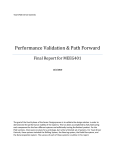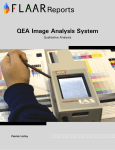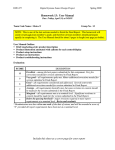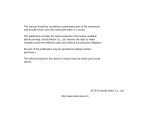Download Twin and Earf - chrisada.co.uk
Transcript
Twin and ‘Erf ’, How I Learned to Love Wiring 0.1 A Guide for EEE Students Undertaking Formula Student Chris Adams [email protected] November 6, 2013 1 Contents 1 Introduction 1.1 What This Document is and What it Isn’t . . . . . . . . . . . 3 3 2 Your Responsibilities 3 3 2011/2012 Rules 4 4 Concepts 4.1 The ECU . . . . . . . . . . . . . . . . . . . 4.2 R6 Engine . . . . . . . . . . . . . . . . . . . 4.2.1 Sensors and Wiring . . . . . . . . . . 4.2.2 Firing Order and Other Data . . . . 4.3 Getting The Engine to Run . . . . . . . . . 4.3.1 ECU Connections . . . . . . . . . . 4.3.2 Calibration and Other Prerequisites 4.4 Running the Engine More Optimally . . . . 4.5 Advanced ECU Features . . . . . . . . . . . 4.6 Car Auxiliaries . . . . . . . . . . . . . . . . 4.7 Loom Building . . . . . . . . . . . . . . . . 4.7.1 Location of Parts . . . . . . . . . . . 4.7.2 Tips . . . . . . . . . . . . . . . . . . 4.8 Electronics . . . . . . . . . . . . . . . . . . 4.8.1 What Will the ECU Do For Me? . . 4.8.2 Driver Interface . . . . . . . . . . . . 4.8.3 Getting Data With Minimal Sensory 4.8.4 Some Design Approaches . . . . . . 4.8.5 A Word on PCB Designs . . . . . . 4.9 Plumbing . . . . . . . . . . . . . . . . . . . . . . . . . . . . . . . . . . . . . . . . . . . . . . . . . . . . . . . . . . . . . . . . . . . . . . . . . . . . . . . . . . . Input . . . . . . . . . . . . . . . . . . . . . . . . . . . . . . . . . . . . . . . . . . . . . . . . . . . . . . . . . . . . . . . . . . . . . . . . . . . . . . . . . . . . . . . . . . . . . . . . . . . . . . . . . . . . . . . . . . . . . . . . . . . . . . . . . . . . 5 5 6 6 7 7 7 9 9 9 10 10 10 10 10 10 10 10 10 10 10 5 On The Day 10 6 Lessons from 2012 10 2 1 Introduction Whilst Formula Student nurtures students to become successful and accomplished engineers, I believe that not enough design documentation occurs at MMU to sustain a steady development cycle. Students come and go, as do undocumented designs. With this document I hope to start a trend where not only the designs, but the design decisions are thoroughly explained in regards to the Electrical and Electronic aspects of the 2012 car. I hope that the mechanical engineers will follow suite. This guide is by no means an authority on the matter, in fact much of it is “Don’t do it like this”, alterations to this guide are encouraged; LATEX source is available from my website, http://chrisada.co.uk. 1.1 What This Document is and What it Isn’t This document is not: • A quick reference for the rules • The ultimate guide for everything auto-electrical This document is: • Designed to inspire further design • One way of doing things • A quick reference for technical information 2 Your Responsibilities As a reader of this guide, you have probably been tasked with managing the Electrical and Electronic aspects of the car. Typically your responsibilities will include: • The Wiring Looms: – Power Distribution – Engine Sensor – Engine Control – Axillary • Using ECU Software 3 • Optional Electronics, which may include: – Driver Interface – Data Logging – Wireless Telemetry – Wireless Video Feed • Management of Axillary Systems Toward the competition you may find that you’ll be left with odd mechanical jobs such as: • Designing Small Brackets • Plumbing • Making References to ‘Twin and Erf’ - See Steve Moyle 3 2011/2012 Rules WARNING: THIS MAY NOT BE UP TO DATE CONSIDER THIS FALSE INFORMATION YOU HAVE BEEN WARNED Reference this section with caution, rules for FS often change, for up to date rules check the FSAE website. Everything that goes on the car must comply with strict rules, which generally involves the following: 1. Master Switches (a) Three switches should be installed (b) Actuating either disables power to all circuits in the car (including alternator) (c) Primary Master i. ii. iii. iv. Must be of rotary type Actuating anti-clockwise disables the power May not act through a relay Must be mounted to the right hand side of the chassis, in-line with the driver’s head 4 (d) Driver Kill Switch i. May act through a relay ii. Must be of push type iii. Pushing on the switch disables power iv. Must be in easy reach of the driver (e) Brake Over-travel Switch i. Positioned mechanically such that A. A loss in brake pressure allows actuation of the switch, disconnecting power to all circuits. B. It’s almost impossible for the driver to re-enable it. ii. May act through a relay • In reality, you’ll find it very difficult to not use a relay. 2. Wiring (a) Any wiring passing through the firewall should be grommeted. (b) The live wire of the battery should be clearly marked along its full extent with yellow tape. 3. Battery (a) It should be fixed securely to the frame (b) The live terminal should be thoroughly insulated from the rest of the car. 4. Brakelight • Not explicitly given in rules as an electrical requirement • Appropriate brightness for distant visibility • Correct height Providing you don’t break these rules and the car goes brum, you’re sorted. 4 4.1 Concepts The ECU In fuel injected cars, the control of the coils, fuel injectors and management of sensors is performed by the ECU; it is an essential component for the car to run. 5 As of November 6, 2013, MMU has two ECUs, both made by DTA, the S60 and S80. The S80 is more feature-full, and is the preferred choice. The S60 may be used for experimentation and development purposes however, as their protocols and software are identical. 4.2 4.2.1 R6 Engine Sensors and Wiring The original coil and injector looms from the R6 should be preserved where possible. Individual connectors are both expensive and difficult to source. As depicted in the ECU wiring diagrams, the common (live) wires for the injectors and coils are wired in parallel, post-fuse, whilst individual coils/injectors are switched to ground. For the most part, wire colouring is intuitive, darker colours are usually ground whilst green and red are preserved for VIN . Where wire colours are not obvious, I have explicitly mentioned them. Below is a table of where sensors can be found when the engine is facing forward with the starter motor on the right hand side. Sensor Name Cam Sensor Location Middle of engine block, behind intake runners Crank Sensor Bottom left of the engine, not far from the exhaust outlet Water Temp Neutral Switch In front of the runners, green plug A single wire brass connector, not too distant from the cam sensor MAP Sensor (Yamaha) Bolted to the fuel rail MAP Sensor (DTA) MAP Sensor (GM) Arbitrary Arbitrary 6 Properties Active sensor, blue is power, black is ground and yellow is output Passive sensor. Helpfully, light grey is ground and dark grey is VOut Polarity is unimportant as it is a resistive load Switches to ground when neutral is active. Extremely unreliable, prone to bouncing, sticking and non-operation. Use of this MAP sensor is discouraged, a DTA and GM are available. Polarity is sensical. 4.2.2 Firing Order and Other Data Fuel Pressure The fuel pressure should be set once using an analogue gauge or the digital gauge connected to the ECU. This is given in the R6 service manual as approximately 3 BAR. But this will be map dependant; in recent years, higher pressures have been used. Ask a grown up. Firing Order This is an all too common mistake that is made when wiring the engine. It shouldn’t be. Firing orders (“What order do the cylinders go bang?”) varies from engine to engine, from left to right it may be 1, 3, 4, 2 or 1, 2, 3, 4, etc. The ECU is designed for 4 cylinder engines, but will support any firing order. It is not possible or required to change the firing order on the ECU. The ECU will fire in ascending order regardless of any settings or any wiring: 1, 2, 3, 4. It is your responsibility to connect the wiring in such a way that the required firing order is achieved. On the Yamaha R6, the firing order is 1, 2, 4, 3. Left to right, with the starter motor on the right hand side. Connections should be made in the following way: ECU Coil 1 Coil 2 Coil 3 Coil 4 4.3 Engine Coil 1 Coil 2 Coil 4 Coil 3 Getting The Engine to Run This section details the absolute bare minimum you’ll need to get a running car. It will be far from optimal, and may not suffice for the competition. 4.3.1 ECU Connections Below are the absolute minimum connections for the ECU to get the car running: • All four coils – The coils can be thought of as one side of a transformer, they are highly inductive. – They control the power to the spark plugs 7 – Peak current can be in excess of 5A each, average current is relatively low. • All four injectors – These are essentially solenoids that control the flow of fuel into the cylinder – Current draw is minimal • The Crank Sensor – The ECU uses this along with the cam sensor to calculate the position of the pistons, such that timing of the sparks and injectors can be controlled – Crank sensors come in two types: ∗ Active (three wires), takes power and returns an amplified signal ∗ Passive (two wires), returns a very weak signal induced by it’s environment • The Cam Sensor – The ECU uses this along with the crank sensor to calculate the position of the pistons, such that timing of the sparks and injectors can be controlled – Like crank sensors, cam sensors come in two types: ∗ Active (three wires), takes power and returns an amplified signal ∗ Passive (two wires), returns a very weak signal induced by it’s environment • The TPS Sensor – The TPS sensor tells the ECU how much throttle the driver is requesting, it’s essentially a waterproof potentiometer that attaches to the throttle body • MAP (Manifold Absolute Pressure) – This tells the ECU what the air pressure inside the manifold is 8 4.3.2 Calibration and Other Prerequisites In addition to the electrical aspects you will also need to ensure that: • The fuel pressure has been calibrated, this can be done once using an analogue gauge. Details can be found later on. • An appropriate map (for the appropriate manifold) is installed on the ECU • Adequate cooling if you plan on running the engine for more than a few seconds. Running the Engine More Optimally While the above section will allow you to start the engine, it will likely be not running at it’s highest performance or highest efficiency. For tuning purposes a lambda sensor should be installed in the exhaust; for initial testing while the engine is on the dyno-rig, a wide-band should be used. This can be later replaced with the narrow band sensor. Installation of the lambda sensor allows the engine to be run in a closed-loop configuration, so it can calculate the FAIR U EL ratio. The lambda sensor requires a 12V heater input, this is controlled by the ECU and as such, does not need to be fused. Additionally, the water temperature sensor should be connected so the ECU can make temperature based adjustments, such as cold-starting. 4.4 Advanced ECU Features The S80 also offers many other features which may be of interest: • Gear Estimation: – Via potentiometer on a sequential gearbox – Gearbox output speed comparison • Traction/Launch Control 9 4.5 Car Auxiliaries 4.6 Loom Building 4.6.1 Location of Parts 4.6.2 Tips 4.7 Electronics 4.7.1 What Will the ECU Do For Me? 4.7.2 Driver Interface 4.7.3 Getting Data With Minimal Sensory Input 4.7.4 Some Design Approaches 4.7.5 A Word on PCB Designs 4.8 Plumbing 5 On The Day 6 Lessons from 2012 7 Lessons from 2013 10
















